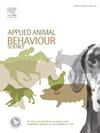Effectiveness of gyroscopes and triaxial accelerometers paired with deep learning algorithms in detecting dairy camel behavior
IF 2.2
2区 农林科学
Q1 AGRICULTURE, DAIRY & ANIMAL SCIENCE
引用次数: 0
Abstract
Nowadays, the behavior of dairy camels in intensive systems has received little attention. This study is the first to use wearable sensors to predict camel behavior, filling a knowledge gap by providing information into their activities. A novel system using triaxial accelerometer and gyroscope sensor was developed to monitor and predict the behavior of six female Maghrebi dairy camels. Using a 10-second time window for data collection, this research effectively distinguishes between key behaviors such as feeding, ruminating, resting, and walking. Various deep learning techniques, including convolutional neural networks combined with long short-term memory (ConvLSTM), dense layer convolutional neural networks, and standalone long short-term memory (LSTM) networks, were used to analyze the data. Results indicate that, under our conditions, camels spent most of the study time feeding, with 33134 occurrences (444 minutes), followed by ruminating 11611 times (156 minutes) and resting 10487 times (140 minutes). In contrast, walking and drinking were much less frequent, with 2627 and 368 occurrences, respectively. The dense-layer CNNs achieved the highest predictive performance with an overall accuracy of 84 %. This model predicted feeding with 89 % accuracy, resting with 67 %, ruminating with 92 %, and walking with 12 %. Following closely, the ConvLSTM model attained an accuracy of 83 %, predicting feeding at 85 %, resting at 76 %, ruminating at 87 %, and walking at 18 %. The LSTM model had a slightly lower overall accuracy of 78 %, predicting feeding at 81 %, resting at 66 %, ruminating at 87 %, and walking at 8 %. In the ConvLSTM model, resting was frequently confused with feeding and ruminating, while walking was often misclassified as feeding. Similarly, the Convolutional with Dense Layers model misclassified resting and walking as feeding, and ruminating as resting. The LSTM model showed similar issues, with resting and walking misclassified as feeding, and ruminating often confused with both feeding and resting. This study highlights the potential of accelerometer and gyroscope sensors as effective tools for assessing camel behavior in intensive systems. The dense layer CNN model showed the best predictive performance, with feeding and rumination behaviors being the most accurately classified. However, walking remained difficult to predict across all models. This is probably due to the limited locomotion of camels in intensive dairy systems. These findings provide a basis for improving automated behavioral monitoring in dairy camels, supporting improved welfare and optimized management in intensive farming systems.
陀螺仪和三轴加速度计配合深度学习算法检测乳骆驼行为的有效性
目前,在集约化系统中,乳骆驼的行为很少受到关注。这项研究首次使用可穿戴传感器来预测骆驼的行为,通过提供骆驼活动的信息来填补知识空白。利用三轴加速度计和陀螺仪传感器,研制了一种新型系统,用于监测和预测六头马格里布雌乳骆驼的行为。这项研究使用10秒的时间窗口来收集数据,有效地区分了关键行为,如进食、反刍、休息和行走。各种深度学习技术,包括卷积神经网络与长短期记忆(ConvLSTM)、密集层卷积神经网络和独立长短期记忆(LSTM)网络,被用于分析数据。结果表明,在本实验条件下,骆驼进食次数最多,为33134次(444 min),反刍次数为11611次(156 min),休息时间为10487次(140 min)。相比之下,走路和喝酒的频率要低得多,分别为2627次和368次。密集层cnn实现了最高的预测性能,总体准确率为84% %。该模型预测进食准确率为89 %,休息准确率为67 %,反刍准确率为92 %,行走准确率为12 %。随后,ConvLSTM模型获得了83 %的准确率,预测进食准确率为85 %,休息准确率为76 %,反刍准确率为87 %,行走准确率为18 %。LSTM模型的总体准确率略低,为78 %,预测进食为81 %,休息为66 %,反刍为87 %,行走为8 %。在ConvLSTM模型中,休息经常与进食和反刍混淆,而行走经常被错误地归类为进食。类似地,卷积密集层模型错误地将休息和行走分类为进食,将反刍分类为休息。LSTM模型也显示出类似的问题,休息和行走被错误地归类为进食,反刍经常被混淆为进食和休息。这项研究强调了加速度计和陀螺仪传感器作为评估集约化系统中骆驼行为的有效工具的潜力。密集层CNN模型的预测效果最好,对进食和反刍行为的分类最准确。然而,行走在所有模型中仍然难以预测。这可能是由于骆驼在集约化的乳品系统中运动受限所致。这些发现为改进乳骆驼的自动化行为监测,支持集约化养殖系统中改善福利和优化管理提供了基础。
本文章由计算机程序翻译,如有差异,请以英文原文为准。
求助全文
约1分钟内获得全文
求助全文
来源期刊

Applied Animal Behaviour Science
农林科学-行为科学
CiteScore
4.40
自引率
21.70%
发文量
191
审稿时长
18.1 weeks
期刊介绍:
This journal publishes relevant information on the behaviour of domesticated and utilized animals.
Topics covered include:
-Behaviour of farm, zoo and laboratory animals in relation to animal management and welfare
-Behaviour of companion animals in relation to behavioural problems, for example, in relation to the training of dogs for different purposes, in relation to behavioural problems
-Studies of the behaviour of wild animals when these studies are relevant from an applied perspective, for example in relation to wildlife management, pest management or nature conservation
-Methodological studies within relevant fields
The principal subjects are farm, companion and laboratory animals, including, of course, poultry. The journal also deals with the following animal subjects:
-Those involved in any farming system, e.g. deer, rabbits and fur-bearing animals
-Those in ANY form of confinement, e.g. zoos, safari parks and other forms of display
-Feral animals, and any animal species which impinge on farming operations, e.g. as causes of loss or damage
-Species used for hunting, recreation etc. may also be considered as acceptable subjects in some instances
-Laboratory animals, if the material relates to their behavioural requirements
 求助内容:
求助内容: 应助结果提醒方式:
应助结果提醒方式:


